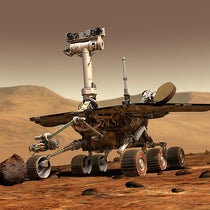Scientist of the Day - Gaetano Crocco
Gaetano Arturo Crocco, an Italian pioneer in aeronautics, was born Oct. 26, 1877. He co-founded Italy's first aeronautics institute in 1908, and much of his early work was with the design of airships. He designed the first pitch controls for propellers, which would make the helicopter possible. He also built the first wind tunnels in Italy. Crocco turned to rocketry in the late 1920s, about the time that Robert Goddard in the United States and Walter Hohmann and others in Germany were designing and testing rockets. Crocco built some of the first solid- and liquid-propellant rockets in Italy. Meanwhile, he taught aeronautics at the University of Rome, until his retirement in 1952, and he also held military rank all the while, rising to the rank of general.
It was after his retirement that Crocco made his great contribution to aeronautics and space science. Ever since rockets were developed in the 1920s, and space flight became a possibility, aeronautical engineers tried to determine if it was physically possible to send a rocket to, say Mars, or whether the weight of the fuel would make it impossible. The consensus was that you could get there, but just barely, since the fuel required would be prohibitive. Hohmann had developed an ingenious transfer orbit that could take a spacecraft from Earth orbit to Mars orbit with the least possible expenditure of energy. But still, even using a Hohmann orbit, it would take 260 days to get to Mars, and then you would have to wait 14 months for the planets to line up properly again, and then another 260 days to get back – that's over 2 and a half years in all.
In 1956, Crocco presented a paper at an international astronautics conference in Rome in which he showed how to go to Mars and back in less than a year. His bright idea was to use the gravitational pull of Venus to help slingshot a spacecraft to Mars and back. The only problem was that the passage by Mars would be at too high an altitude to make useful observations of the planet. So Crocco proposed that by using something called gravity-assist, where you use the gravitational attraction of Venus and Mars to add velocity to the spacecraft, you could use much less fuel, and you could pass by Mars at a much lower altitude. Gravity assist would turn out to be invaluable when the space age began in 1957. Many of the NASA missions of the 1960s and 70s – such as Voyager 1 and 2 – would have been impossible without the use of gravity assist. The Galileo spacecraft that we discussed here just last week used the gravity-assistance of Venus and Earth to get to Jupiter in in much the way that Crocco proposed. Crocco was not the first to think of the idea of gravity assist – Guido von Pirquet had seen the possibilities decades earlier – but Crocco was the first to work out detailed orbits, which you can see in the diagrams included in his 1956 paper, in the Proceedings of the congress, which we have in the Library (second and third images).
There is a wonderful scene in the film The Martian (2015), where a young aerospace engineer named Rich Purnell, using a stapler for a spacecraft, shows the NASA brass how you could send a rescue mission to Mars by sling-shoting the returning spacecraft around the Earth and getting back to Mars in time to rescue the stranded astronaut before he runs out of food. Later the astronauts in the Hermes spacecraft tell NASA that Rich Purnell is a “steely-eyed missile man,” apparently a high compliment within NASA. When I see Purnell (played by Donald Glover) with his stapler walking though the proposed orbit (you can see that scene here) I can't help thinking of Gaetano Crocco, even though he was nearly 80 years old when he had the idea that Rich Purnell was putting into practice in the NASA director's office.
Crocco was inducted into the International Space Hall of Fame at the New Mexico Museum of Space History in 1976. There are not many photos of Crocco available online, but it is interesting that in the photos taken before 1950, when he was in the military, he looks fierce and glowering. In those taken when he was in his eighties, he looks much more mellow. I wish we had more of the latter.
William B. Ashworth, Jr., Consultant for the History of Science, Linda Hall Library and Associate Professor emeritus, Department of History, University of Missouri-Kansas City. Comments or corrections are welcome; please direct to ashworthw@umkc.edu.










